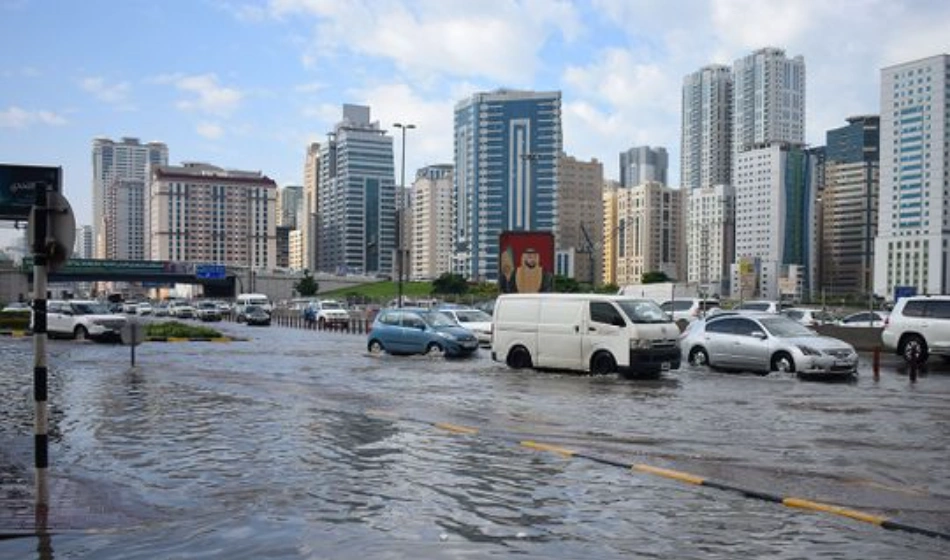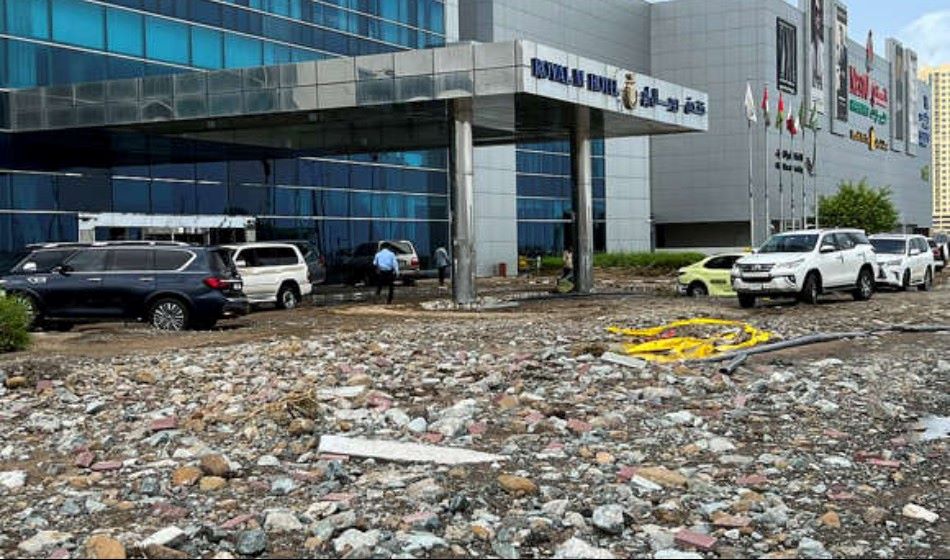Unraveling the Mysteries of Dubai Flood: A Comprehensive Analysis

The Unusual Weather Patterns In Dubai
Dubai, the iconic city renowned for its architectural marvels and luxury lifestyle, as well as its scorching temperatures and desert landscape, has recently been experiencing some unusual weather pattern; what some call “The Mysteries Of Dubai Flood. Residents are puzzled by the sudden heavy rain and flash floods that struck the city in April 2024, delivering a year’s worth of rainfall in just 12 hours. Many are questioning the reasons behind these extreme weather occurrences, with some suggesting that climate change could be the culprit.
The summers in Dubai are popular for the intense high temperatures and their arid sandy surroundings. In the end, floods of various sizes struck most parts of the city with the hefty rain, making people to suffer. Climatologists have already been warning us for years now that more powerful and less forecastable weather, which is caused by the human-induced climate change, is actually becoming common all over the world.
Meteorologists are studying the data to understand what is causing these unprecedented weather patterns in Dubai. Is it simply a freak occurrence or is there a larger environmental issue at play? As residents clean up after the floods and try to make sense of this mysterious weather phenomenon, one thing is certain – Dubai’s climate may not be as predictable as once thought.
The Mystery of Dubai Flood That Baffled Residents
In the middle of the desert, an extremely rare part indeed, Dubai witnessed series of mystifying floods that caused everyone to raise their eyebrows. The floods were a real shock, with no storms or heavy rains the day before, and as a result, nobody on the ground was prepared. Roads were underwater, cars dropped off, and homes filled with water.

In a surprising turn of events, Dubai finds itself grappling with torrential rains and widespread flooding, sparking curiosity and concern among residents and visitors alike. Damning pictures show drenched cars left abandoned on the roadside and homes almost half full with water.
The cause of the flooding has been left unanswered by officials, who are still making efforts to explain how such dry area can be surrounded by water so soon. Among the residents were rumors, some of whom said that it was an abnormal weather related phenomenon and others who thought it was the start of something more evil in the making. With clean-up operation already started and normal life returning, the haze of Dubai floods still continued hovering above the minds of those who had witnessed them.
Investigating The Possible Causes Of The Flooding
Unlike many flood-prone regions, Dubai receives very little rainfall. So, what caused these floods to disrupt life in the usually arid city? The answer lies in a complex interplay of factors:
Intense Rainfall: The Mysteries Of Dubai Flood
While uncommon, Dubai can experience sudden downpours known as wadi flash floods. These occur when heavy rainfall over short periods overwhelms drainage systems, causing water to accumulate rapidly in low-lying areas. Climate change may be increasing the frequency and intensity of these events.
Cloud Seeding: Cloud seeding operations occurred in the UAE during the storm, but they did not directly induce the flooding. The heavy rainfall, not attributable to cloud seeding, primarily caused the flooding.
Climate Change: A Looming Threat
The research underway is focused on determining the precise role climate change plays in Dubai floods. It’s challenging to ignore the potential impact it may have on flooding. Scientists link rising global temperatures and changing weather patterns directly to increased catastrophes and damaging events. Examples include heavy rainfall and flooding. Dubai’s coastal location and low-lying topography make it particularly vulnerable to the effects of climate change.
Image of Dubai Wadi Flash Flood Opens in a new window

- Urbanization and Lost Permeability: Dubai’s rapid urban expansion has come at a cost. The replacement of permeable surfaces like sand and vegetation with impervious concrete reduces the ground’s ability to absorb water. This increases surface runoff, leading to flash flooding in areas with inadequate drainage capacity.
- Rising Sea Levels: As global temperatures rise, sea levels are also on the ascent. This poses a threat to coastal cities like Dubai, as storm surges can combine with heavy rainfall to exacerbate flooding risks.
- Storm Surges: Powerful storms can push seawater onto land, causing coastal flooding. While less common in Dubai compared to wadi flash floods, storm surges can still pose a significant threat, particularly to low-lying coastal areas.
- Poor Drainage Systems: Dubai’s rapid expansion and breakneck pace of development often outpaced the city’s ability to implement adequate stormwater management systems. As the skies unleashed their fury, the city’s drainage infrastructure proved woefully inadequate, failing to channel the torrential downpour effectively.
Dubai Flood Impacts: Assessing the Aftermath
The Dubai flood left a trail of devastation in its wake, affecting various aspects of the city’s infrastructure, economy, and daily life. Understanding the far-reaching impacts of this event is crucial for developing comprehensive mitigation and recovery strategies.
- Infrastructure Damage: The Dubai flood caused significant damage to the city’s infrastructure, including roads, bridges, and buildings. Flooding inundated homes, businesses, and public facilities, causing structural damage and the loss of valuable assets. The repair and reconstruction efforts required to restore the affected areas will likely impose a substantial financial burden on the city’s resources.
Transportation Disruptions: The flood stressed Dubai’s transport infrastructure. Many roads became unserviceable. It forced suspension of public transport service. This complicated puzzle entangled residents. It affected the city’s economy. It dismantled the movement of goods and services.

- Economic Losses: The Dubai flood has had far-reaching economic consequences, affecting various sectors of the city’s economy. The business interruption, property damage, and cash dip from cleanup and disaster recovery have nearly dealt a fatal blow to the city’s financial health. The tourism industry, a major contributor to Dubai’s economy, has also been affected. This impact extends to the city’s image and infrastructure.
- Public Health Risks: In the wake of the flood, public health risks have emerged as a pressing concern. Stagnant water can provide a breeding ground for insects that carry diseases and germs, posing a threat to the health of Dubai residents. Additionally, water source pollution and the risk of waterborne diseases have heightened public health concerns.
- Environmental Concerns: The Dubai flood has had significant environmental implications. The flooding of urban areas has resulted in the release of pollutants into the city’s waterways, posing a threat of lasting damage to fragile ecosystems. Additionally, the disturbance of natural habitats and the displacement of wildlife have worsened the environmental challenges arising from the flood.
Dubai Flood Management: A Proactive Approach
In the aftermath of the flood, Dubai’s authorities have recognized the urgency of implementing comprehensive flood management strategies to mitigate the impacts of future occurrences. These strategies encompass a range of measures aimed at enhancing the city’s resilience and preparedness.
- Storm water Management Systems: The Vital Line of Defense. One of the essential priorities for Dubai’s flood management measures is the development and deployment of effective storm water management systems. These systems have a network of drainage channels and retention basins. They are able to collect and divert excess rainwater away from urban areas during heavy rainfalls.
- Flood Warning Systems: Early Detection, Timely Action. Accurate and timely flood warnings are crucial for minimizing the impact of such events. Dubai is actively investing in advanced flood warning systems that leverage cutting-edge technologies such as remote sensing, hydrological modeling, and real-time data monitoring. These systems aim to provide early alerts to authorities and residents, enabling prompt evacuation and mitigation efforts.
- Emergency Response Plans: Coordinated Action in Times of Crisis. Effective emergency response plans are essential for ensuring the safety and well-being of Dubai’s residents during flood events. These plans outline clear protocols for emergency services, evacuation procedures, and the coordination of resources to minimize the loss of life and property. Regular drills and simulations are conducted to ensure the preparedness of all stakeholders involved in the emergency response efforts.
Mitigation Measures: Building a Resilient City.
By taking forward the proactive mitigation measures, which are based on the lessons learnt from past flood incidents, Dubai intends to limit the penalties of future floods and skyrocketing risk levels. These approaches comprise the adoption of rigid developing rules, human habitation permissions, and utilization of building codes. Natural drainage channels with its them called should set as priorities. Besides that, Dubai focus on the green city practices in the effort of achieving urban sustainability. The marginal management practices concerning water resources and environmental protection are among the features.
Unraveling The Truth Behind The Dubai Flood Mystery
In the wake of the flood, Dubai has mobilized dedicated investigation teams to thoroughly analyze the event and uncover its root causes. These investigations are critical for identifying vulnerabilities, implementing corrective measures, and learning valuable lessons for the future.
- Investigation Teams: The Dubai flood investigation teams comprise experts from various fields. These fields include hydrology, meteorology, urban planning, and engineering. This multidisciplinary approach ensures a comprehensive examination of the event. It takes into account the diverse factors that contributed to its occurrence.
- Data Analysis: Deciphering the Clues. Extensive data collection and analysis are at the heart of the investigation process. Teams are meticulously analyzing rainfall patterns, hydrological data, infrastructure performance, and eyewitness accounts to piece together a detailed timeline and understand the flood’s progression.
- Root Cause Analysis: Unraveling the Enigma. Building upon the data analysis. The investigation teams delved deeper into the root causes of the flood. Scrutinizing the complex interplay of natural and human-induced factors. From climate change impacts to urban planning decisions. No stone was left unturned in the pursuit of understanding the event’s fundamental drivers.
- Lessons Learned: Fortifying for the Future. The conclusions from those research projects will bring forth the hidden secrets about the Dubai flood. Moreover, they will turn to be golden rules of conduct for the city as well. The strategy will be to enhance the area’s resistance to upcoming natural calamities. By incorporating these lessons into urban planning, infrastructure development, and emergency preparedness strategies. Dubai can emerge stronger and better equipped to tackle the challenges posed by extreme weather events.
The Mysteries Of Dubai Flood: Lessons Learned
Infrastructure Upgrades: Dubai’s infrastructure needs to be upgraded to handle extreme weather events, including heavy rainfall and flooding
- Climate Change Mitigation: Dubai must address climate change by reducing greenhouse gas emissions and promoting sustainable development practices
- Urban Planning: City planners should focus on sustainable urban planning practices, including developing green spaces, expanding permeable surfaces, and encouraging water conservation.
- Community Preparedness: Residents and businesses in Dubai must be prepared for extreme weather events, with emergency response plans, flood awareness, and preparedness training
Conclusion
The Dubai flood of April 2024 has undoubtedly challenged the city’s resilience and exposed vulnerabilities that were once thought unimaginable. The mysterious flood unravels a complex interplay of climate change, urbanization, and infrastructure challenges. By understanding the causes, impacts, and management strategies, Dubai and other cities can take steps to prevent and mitigate future flooding incidents. Through preparedness, collaboration, and a commitment to sustainability. They can navigate the uncertainties of a changing climate. And ensure a safer, more resilient future for all.










